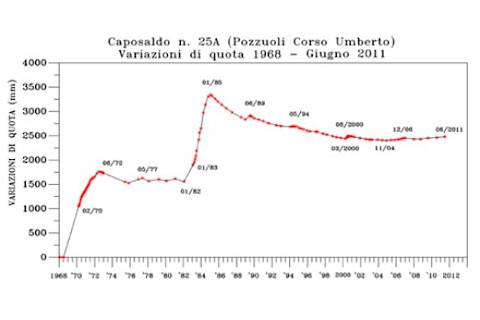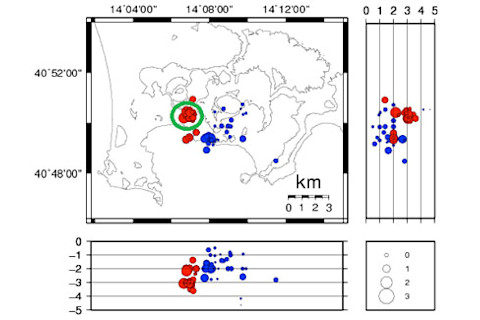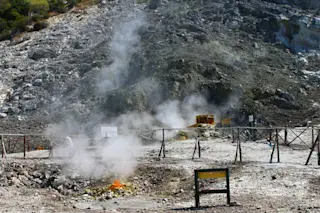La Solfatara, part of the Campi Flegrei caldera in Italy. Active fumaroles are signs of the active nature of the caldera. Image taken September 2010. Photo: Justin Ennis/Flickr Active calderas are captivating features. Not only are places like Yellowstone, Taupo, Taal, the Campi Flegrei and others some of the largest volcanic features on the planet, they are also some of the most restless. The land surface rises and falls, hot springs, geysers and mud pools gurgle away, earthquake swarms rumble, lakes in the caldera see their temperatures change regularly -- and much of this occurs a long time away from any potential eruption. Even changes that seem dramatic might only be the day-to-day variations in the caldera, so parsing out what is a signal of new activity and what is merely a caldera being a caldera can be tricky. One caldera that might be the most potentially hazardous on the planet is the Campi Flegrei in Italy. As the recent NASA Earth Observatory image of the region shows, there are an awful lot of people who live near the Campi Flegrei caldera. Understanding what might be happening in the subvolcanic system is vital if there is any hope of getting people out of harm's way if the caldera decides to erupt again. Geologically, it hasn't been that long since the last eruption at the Campi Flegrei -- the last eruption was in 1538, merely 474 years ago. To put that into perspective with other caldera systems, people get all uppity about Yellowstone and that caldera hasn't erupted for over 70,000 years! So, the Campi Flegrei is definitely an active volcanic system and we should expect to see signs of that. Some of those signs are readily apparent, like La Solfatara, the fumarole field near Pozzuoli, or the famed Roman columns that show evidence of seawater inundation in the past -- a record of the rising and falling of the land surface along the Bay of Pozzuoli. INGV keeps a close eye on the activity at Campi Flegrei, monitoring things like seismicity, land surface deformation, hydrothermal vent temperatures and gas chemistry. Right now, Campi Flegrei is about as closely watched as any volcano on Earth! So, when rapid changes begin to occur, we know about it quickly.

Changes in the land surface at Pozzuoli in the Campi Flegrei caldera from 1968 to 2013. Image: INGV. Since late 2012 into 2013, there have been some interesting changes in the activity at the Campi Flegrei. A recent bulletin (in Italian) put out by the Osservatorio Vesuviano (watching over Campi Flegrei, Vesuvius and Ischia) tackles some of the changes in deformation that has been occurring. First, a little context: since the mid-1980s, the caldera surface had been slowly subsiding (see left). However, for a period of a few years in the early 1980s, there was rapid uplift within the caldera -- upwards of 2 meters in only three years between 1982-85. There was concern that the Campi Flegrei might have been headed for an eruption, as along with this uplift came earthquake swarms ... but, nothing happened. Likely, a new slug of magma intruded* at depth under the Campi Flegrei, but it didn't lead to any eruption. Now, since early 2012, parts of the caldera around Pozzuoli have been rising quite impressively, on the order of 70 mm (0.07 meters) in a little over a year. That isn't anywhere near the rates of uplift from the early 1980s, but it is still notable. It seems that multiple GPS stations are showing a radial uplift centered in the caldera, all suggesting that the floor of the caldera is bulging upwards since early 2012. There have also been swarms of earthquakes during the past year and a half, mostly centered under the northern shores of the Bay of Pozzuoli at depths of 1-4 kilometers (see below left). Some of the other parameters watched at Campi Flegrei have changed as well -- temperatures at the fumaroles have increased 10-15°C since 2003, the composition of gases released in the caldera have also become more "magmatic", which higher carbon dioxide/water since 2000.

Earthquakes in the Campi Flegrei area since August 2012. Image: INGV. What does this all mean? Well, [speculation alert!], there are likely a few potential culprits. First, this could merely be the continuation of the intrusion of magma that started in the 1980s. Now, with all the deflation from 1985-2000, that might not be too likely. This could be merely changes in the hydrothermal system, but the change in the composition of gases being released suggest magma is involved. This could also be a new intrusion of magma under the caldera at depths of ~5 km (based on the earthquakes) -- combine that with the surface uplift (to accommodate new magma), the gas compositions and warming fumaroles, and it seems like a good hypothesis. Now, before everyone goes running to the hills, remember, the last intrusion during the 1980s was much more dramatic and it didn't lead to any eruption. So, there is a very high likelihood that this intrusion isn't going to lead to any new eruption. I've mentioned this before, but it is worth reiterating: we know more about the day-to-day changes at active volcanoes today than we have ever known. Subtle changes, including what is happening now at Campi Flegrei, may not have even been noticed in the past. So, we are really only working with a few decades worth of comparable data to understand how common or uncommon events like this might be. So far at the Campi Flegrei, it seems that intrusions of magma at depth might be fairly common -- likely more common than eruptions themselves. The questions for geologists to answer is the relationship between the size and timing of these intrusions and eruptions -- and what size eruption could be expected. Research into these active caldera, like the drilling project at the Campi Flegrei, can help get at some of these questions of what it means to be a "restless caldera," so hopefully the next time the Campi Flegrei is going to erupt, we'll have a better sense of what signs to expect before it happens. * I have seen some suggestion that inflation/deflation at the Campi Flegrei is strongly controlled by compaction of volcanic tephra from the Campanian Ignimbrite (39,000 years ago). Seems like the debate is still open to some extent of what the restlessness at Campi Flegrei means.














